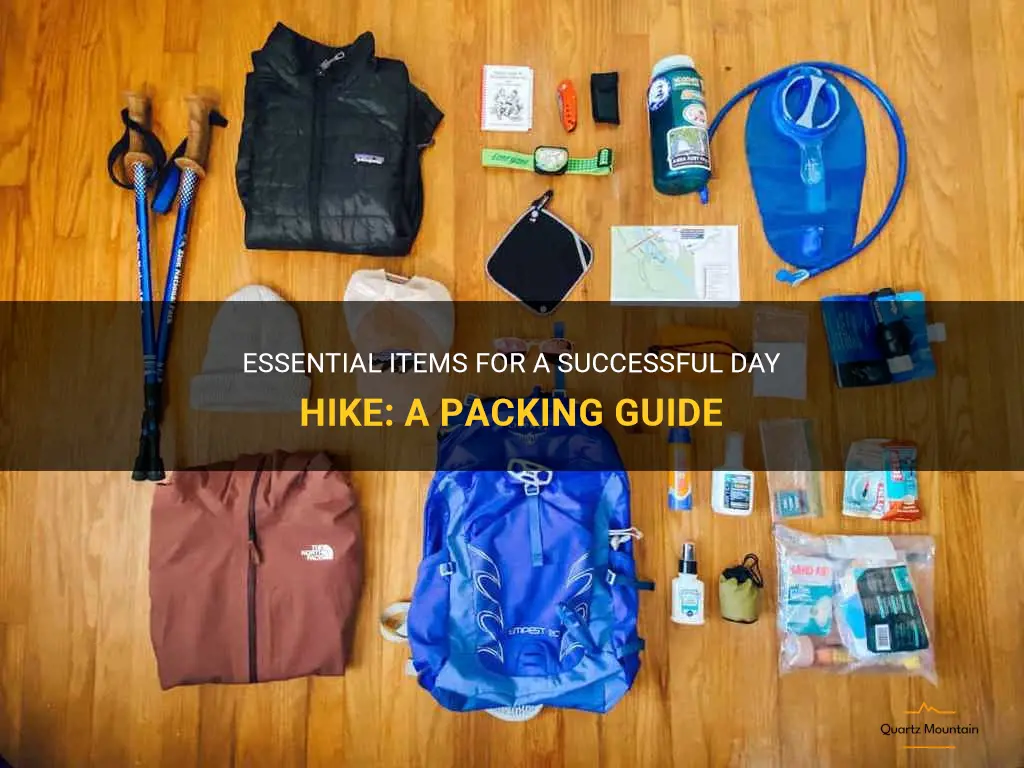
Are you ready to embark on an exciting day hike but not sure what essentials to bring along? Look no further! In this packing guide, we will cover all the necessary items you need to ensure a successful and enjoyable day hike. Whether you're a seasoned hiker or a beginner, having the right gear and supplies can make all the difference in your adventure. So, grab your backpack and let's get packing!
| Characteristics | Values |
|---|---|
| Backpack | Daypack or small backpack |
| Clothing | Weather-appropriate clothing (layers) |
| Footwear | Hiking shoes or boots |
| Navigation | Map, compass, GPS device |
| Sun protection | Sunscreen, hat, sunglasses |
| Water | At least 2 liters |
| Food | Snacks, lunch, energy bars |
| First aid kit | Basic first aid supplies |
| Survival essentials | Whistle, fire starter, emergency blanket |
| Communication | Cell phone, whistle |
| Illumination | Headlamp or flashlight |
| Extra clothing | Extra socks, jacket |
| Rain gear | Rain jacket, rain pants |
| Insect repellent | Bug spray or lotion |
| Personal items | Wallet, identification |
| Optional items | Camera, binoculars, trekking poles |
What You'll Learn
- What are the essential items to pack on a day hike?
- Do you recommend carrying a first aid kit for a day hike If so, what should be included in it?
- Are there any specific clothing or footwear recommendations for a day hike?
- What type of food and water should be packed for a day hike?
- Are there any additional items or gear that would be beneficial to bring on a day hike?

What are the essential items to pack on a day hike?
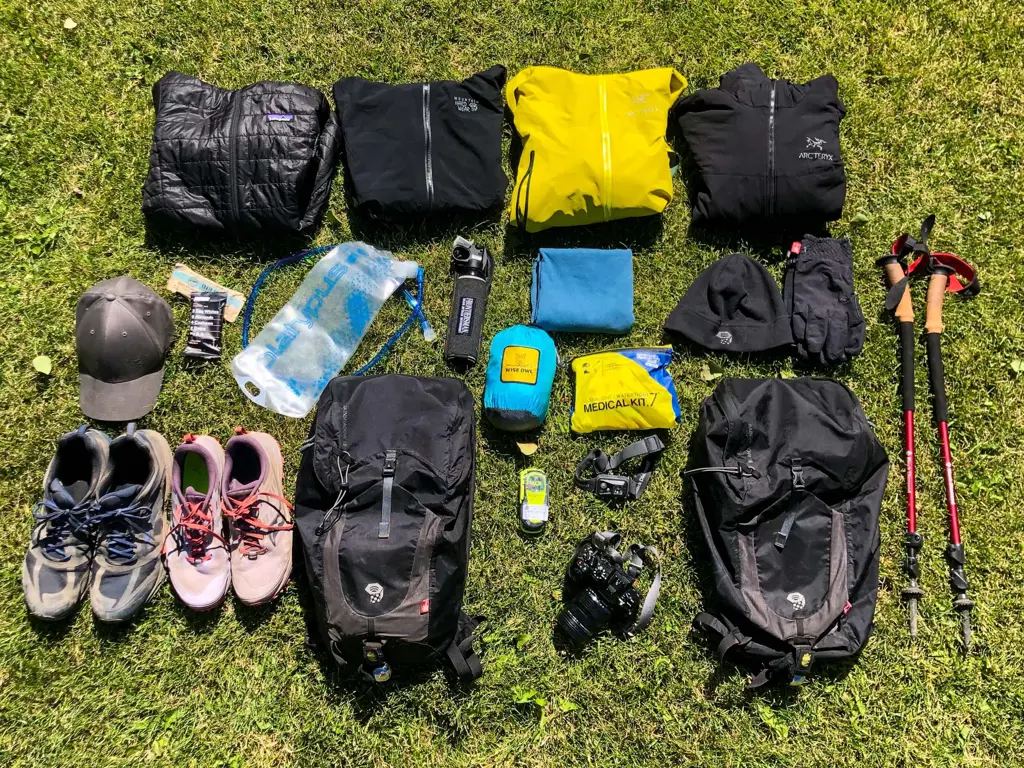
When planning a day hike, it is essential to pack the right gear to ensure a safe and enjoyable outing. While the specific items you need may vary depending on the length and difficulty of the hike, there are a few essential items that every hiker should have with them. This article will outline the key items you should pack on a day hike, along with some tips and examples to help you prepare.
- Backpack: A well-fitting backpack is crucial for carrying all your hiking gear. Look for one with padded shoulder straps and a hip belt to distribute the weight evenly and reduce strain on your back.
- Map and Compass: Even if you're hiking in a well-marked area, it's important to have a map and compass as a backup. These tools can help you navigate in case you get lost or encounter unexpected detours. It's also a good idea to familiarize yourself with the map before you start your hike.
- Water: Staying hydrated is essential, especially during physical activity. Pack enough water for the duration of your hike, and consider using a water bladder or water bottles with built-in filters for convenience. Remember to start hydrating before your hike and continue to drink regularly throughout the day.
- Snacks and Meals: Fueling your body with nutritious snacks and meals is crucial for maintaining energy levels during a hike. Choose lightweight, non-perishable foods such as granola bars, trail mix, dried fruits, and sandwiches. Also, pack enough food for unexpected delays or emergencies.
- Extra Clothing: Weather conditions can change quickly, even on short hikes. Pack extra layers of clothing to prepare for temperature drops, rain, or strong winds. A waterproof jacket, hat, gloves, and a warm sweater or fleece are essential items to have in your backpack.
- First Aid Kit: Accidents and injuries can happen on the trail, so it's important to carry a basic first aid kit. Include items such as bandages, antiseptic wipes, pain relievers, blister pads, and any personal medication you may need. Familiarize yourself with the contents of your first aid kit and learn basic first aid techniques before heading out.
- Sun Protection: Protecting your skin from the sun's harmful rays is crucial during a day hike. Pack sunscreen with a high SPF, sunglasses to protect your eyes, and a wide-brimmed hat to shield your face and neck from the sun. Consider bringing lip balm with SPF as well.
- Navigation Tools: In addition to a map and compass, it's helpful to have a GPS device or a smartphone with a navigation app. These tools can provide real-time tracking and help you stay on the right trail. Ensure your device is fully charged and consider bringing a power bank to recharge if needed.
- Multi-Tool: A multi-tool with a knife, pliers, and other essential tools can be handy for various tasks on the trail. It can be used for repairing gear, cutting branches, opening cans, or any other unexpected needs that may arise.
- Emergency Supplies: Lastly, pack some emergency supplies such as a whistle, flashlight, extra batteries, and a space blanket. These items can be crucial in case of an emergency or if you get stranded overnight.
Example:
Let's consider a specific example. If you are planning a day hike in the Rocky Mountains during the summer, you should pack additional items specific to the region and season. It's important to bring extra layers of warm clothing, as temperatures can drop significantly at higher elevations. You should also be prepared for afternoon thunderstorms by packing a lightweight rain jacket and a small umbrella. Additionally, consider bringing a bear spray if the area is known for bear encounters. Research the specific regulations and guidelines for the area you will be hiking in to ensure you have everything you need.
In conclusion, packing the right gear is essential for a successful day hike. From backpacks and maps to water and snacks, each item plays a crucial role in ensuring your safety and comfort on the trail. By following these guidelines and considering the specific requirements of your hike, you'll be well-prepared to tackle any adventure that comes your way.
Essential Items to Pack for a Soccer Trip
You may want to see also

Do you recommend carrying a first aid kit for a day hike? If so, what should be included in it?
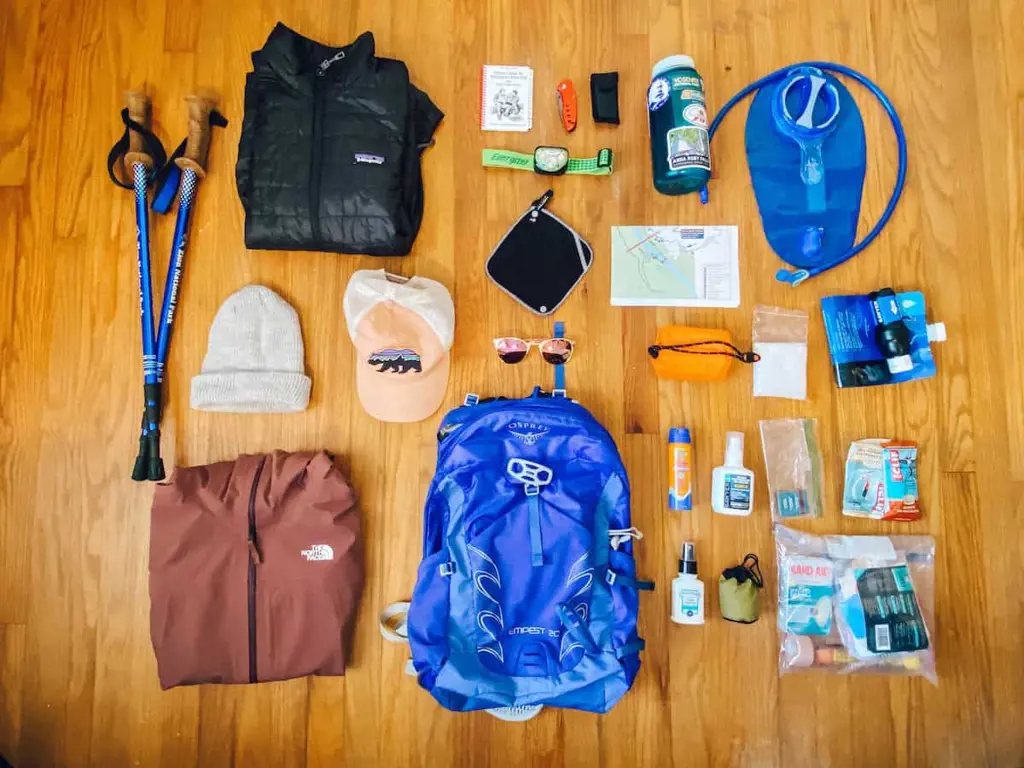
When it comes to going on a day hike, it is always a good idea to be prepared for any unexpected situations that may arise. Carrying a first aid kit can be a lifesaver in such cases. In this article, I will discuss why it is important to carry a first aid kit on a day hike and what items should be included in it.
First and foremost, accidents can happen to anyone, anywhere, and at any time. While day hikes are generally considered to be safe, there is always a risk of injuries such as sprained ankles, cuts, scrapes, or even more serious incidents like broken bones or allergic reactions. Having a first aid kit on hand can help provide immediate care and prevent these injuries from worsening.
So, what should a basic first aid kit for a day hike contain? Here are some essential items to include:
- Antiseptic wipes or solution: These are used to clean wounds and prevent infection. They can be used to clean small cuts, scrapes, or burns that may occur during your hike.
- Band-Aids or adhesive bandages: These are useful for covering minor cuts, blisters, or abrasions. It is recommended to have a variety of sizes to suit different types of injuries.
- Sterile gauze pads: These are used to cover larger wounds that cannot be adequately covered with a Band-Aid. They help to stop bleeding and provide a clean surface for wound healing.
- Adhesive tape: This is used to secure gauze pads in place or to tape splints in case of a fracture or sprain. It is important to choose a tape that is hypoallergenic and sticks well to the skin, even in wet conditions.
- Tweezers: These are handy for removing splinters, ticks, or other foreign objects from the skin. It is important to clean tweezers with alcohol before and after use to prevent infection.
- Elastic bandage: This can be used to wrap sprained or strained joints, providing support and stability. It is important to apply the bandage correctly to avoid restricting circulation.
- Pain relievers: Non-prescription pain relievers such as ibuprofen or acetaminophen can be included in the kit to provide relief from minor aches, pains, or headaches that may occur during the hike.
- Antihistamines: These can be useful in case of an allergic reaction to insect bites or contact with certain plants. They can help reduce symptoms such as itching, swelling, or hives.
- Cold pack: This can be useful for reducing swelling and relieving pain from sprains, strains, or bruises. Cold packs can be activated by squeezing them to release a chemical reaction that provides cold therapy.
- Emergency contact information: It is crucial to have a list of emergency contact numbers, including local emergency services, park rangers, and any personal emergency contacts. This information should be easily accessible in the first aid kit.
Remember, the above list is just a starting point for creating a basic first aid kit for a day hike. Depending on the length and location of your hike, you may need additional items such as blister pads, snakebite kits, or specific medications for pre-existing conditions. It is always a good idea to do some research and tailor your first aid kit to your specific needs and the environment you will be hiking in.
In conclusion, carrying a first aid kit on a day hike is highly recommended. It can provide immediate care for minor injuries and potentially save you from more serious consequences. By being prepared and equipped with the necessary items, you can ensure a safer and more enjoyable hiking experience.
Essential Items for Your Hospital Delivery Bag
You may want to see also

Are there any specific clothing or footwear recommendations for a day hike?
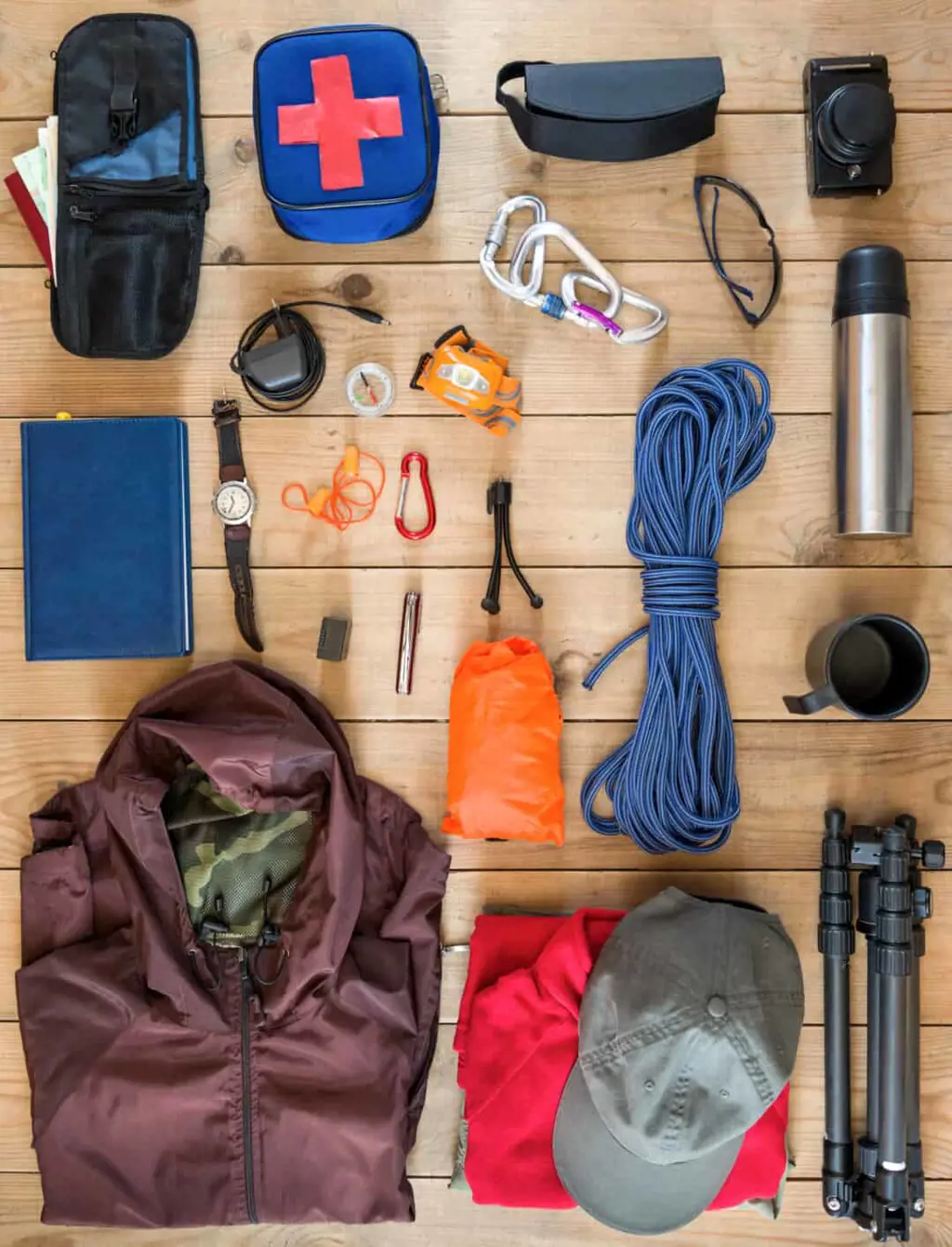
When it comes to a day hike, wearing the right clothing and footwear is essential for your comfort, safety, and overall enjoyment of the experience. Whether you are hiking on a well-maintained trail or exploring off the beaten path, here are some specific recommendations to consider:
- Layered Clothing: Dressing in layers is crucial for outdoor activities like hiking, as it allows you to adapt to changing weather conditions and regulate your body temperature. Start with a moisture-wicking base layer to keep you dry and comfortable. This could be a lightweight, long-sleeved shirt and pants. Over the base layer, add an insulating mid-layer like a fleece or a down jacket to provide warmth. Finally, top it off with a breathable and waterproof outer layer to protect you from rain, wind, and snow.
- Hiking Pants: Opt for pants made of quick-drying and durable fabric. Look for features such as reinforced knees and water-resistant coatings. Convertible pants with zip-off legs are ideal for variable weather conditions, allowing you to switch between pants and shorts.
- Hiking Socks: Invest in a good pair of moisture-wicking, cushioned hiking socks. These socks provide extra support and help prevent blisters. Merino wool socks are an excellent choice as they wick away moisture and keep your feet dry and comfortable throughout the hike.
- Hiking Boots: Proper footwear is crucial for a day hike, as it provides traction, stability, and protects your feet from rough terrain. Choose hiking boots that offer ankle support, have a sturdy sole with deep treads for grip, and provide ample protection against rocks, roots, and other obstacles on the trail. Make sure to break in your boots before hitting the trail to avoid discomfort and blisters.
- Hat and Sunglasses: Protect yourself from the sun's harmful rays by wearing a wide-brimmed hat and sunglasses. The hat will shield your face and neck from direct sunlight, while the sunglasses will protect your eyes from UV rays and glare.
- Gloves: Depending on the weather conditions and the terrain you plan to hike, consider wearing lightweight gloves to protect your hands. They will provide insulation and shield your hands from scratches, cold temperatures, and rough surfaces.
It is always advisable to check the weather forecast before heading out on a day hike. Additionally, consider the specific terrain, elevation, and difficulty level of the trail you'll be hiking. Different conditions may require additional or specialized gear, such as gaiters for snowy or muddy trails or crampons for icy surfaces.
Remember, being prepared with the right clothing and footwear can make a significant difference in your hiking experience. It will keep you comfortable, protect you from the elements, and reduce the risk of injuries. So, pack your daypack with the necessary gear and enjoy your hike!
Essential Items to Pack for a Memorable Canoe Trip
You may want to see also

What type of food and water should be packed for a day hike?
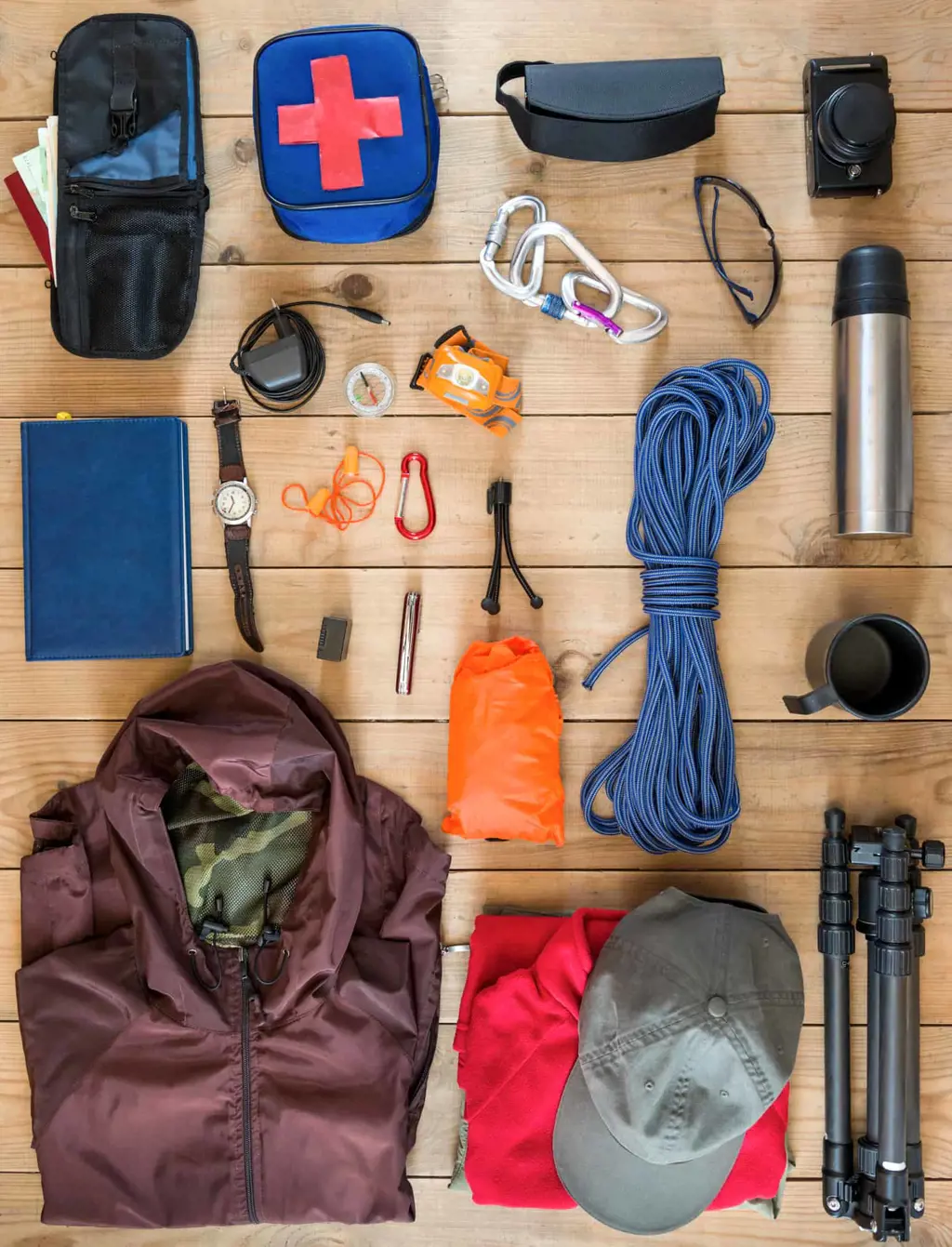
When going on a day hike, it is important to pack the right type of food and water to ensure you have enough energy to sustain your activity level. The food and water you pack should be lightweight, non-perishable, and easy to consume on the go.
First and foremost, water is the most critical item to bring on a day hike. It is essential to stay hydrated throughout your hike to prevent dehydration and maintain optimal performance. The general rule of thumb is to drink at least half a liter of water per hour of moderate activity. Depending on the length and intensity of your hike, you may need to pack several liters of water. It is advisable to use a hydration bladder or water bottles that are ergonomic and leak-proof to make drinking on the go convenient.
In addition to water, packing snacks and meals that provide a good balance of macronutrients is essential for sustained energy during your day hike. Carbohydrates are the primary source of energy for physical activity, so it is important to include foods that are rich in carbs. Some ideal options include energy bars, trail mix, whole wheat wraps, or granola. These foods are easy to carry, require no refrigeration, and provide a quick source of energy.
Protein is also important for repairing and building muscles during physical activity. Consider packing jerky, individual packets of tuna or salmon, or protein bars. These options provide a good source of protein without the need for refrigeration.
Fruits and vegetables are also great to include in your day hike food pack as they provide essential vitamins and minerals. Apples, oranges, bananas, and pre-cut carrot sticks are all excellent choices. They are lightweight, easy to pack, and provide a refreshing and nutritious snack.
Lastly, it is important to consider any dietary restrictions or allergies you may have. If you have gluten sensitivities, look for gluten-free options for your snacks and wraps. If you are a vegan or vegetarian, choose plant-based protein sources or alternatives. It is crucial to plan your meals and snacks accordingly to avoid any health issues or discomfort while on your hike.
To summarize, when packing food and water for a day hike, prioritize hydration by bringing enough water to last the duration of your hike. Pack lightweight and non-perishable snacks that provide a balance of carbohydrates and protein for sustained energy. Include fruits and vegetables for essential vitamins and minerals, and consider any dietary restrictions you may have. By doing so, you can enjoy your day hike without worrying about running out of energy or becoming dehydrated.
Packing Essentials for St. George's University: Your Complete Guide
You may want to see also

Are there any additional items or gear that would be beneficial to bring on a day hike?
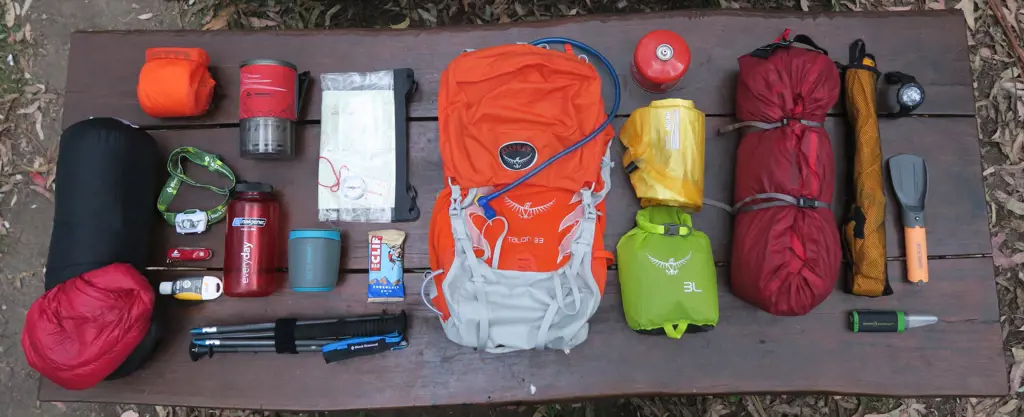
Going on a day hike can be a fantastic way to enjoy nature and get some exercise. Whether you're hitting the trails for a leisurely stroll or a more challenging trek, there are a few additional items and gear that can enhance your hiking experience and ensure that you are prepared for any situation.
One of the most important things to bring on a day hike is a map or a trail guide. Even if you're familiar with the area, having a map can help you stay on track and avoid getting lost. It's also a good idea to bring a compass or a GPS device in case you need to navigate your way back to the trailhead.
Another essential item to pack for a day hike is a first aid kit. Accidents can happen, and having a basic first aid kit can help you treat minor injuries and provide temporary relief until you can get help. Your first aid kit should include items like bandages, antiseptic wipes, pain relievers, and any necessary medications.
Depending on the weather and the terrain, it may also be necessary to bring extra clothing and gear. Even on a warm day, temperatures can drop quickly in the mountains or other higher elevations. Pack a lightweight jacket or a rain shell to protect yourself from sudden changes in weather. It's also a good idea to bring a hat, gloves, and extra socks in case you get wet or need some added warmth.
In addition to these essential items, it's also a good idea to bring some food and water. Pack enough snacks to keep you energized throughout your hike, such as trail mix, energy bars, or fruit. It's important to stay hydrated, so bring enough water or a water filter to refill your bottles along the way.
Other useful items to bring on a day hike include a flashlight or headlamp, a multi-tool, and a whistle. A flashlight can help you navigate in low-light conditions or in case you get caught out after dark. A multi-tool can come in handy for various tasks, such as fixing gear or opening cans. And a whistle can be used to signal for help if you find yourself in an emergency situation.
Finally, don't forget to bring a backpack or a daypack to carry all of your gear. Look for a backpack that is comfortable to wear and has enough space for your belongings. It should have adjustable straps and padding to prevent any discomfort while hiking.
In conclusion, there are several additional items and gear that can be beneficial to bring on a day hike. These include a map or trail guide, a first aid kit, extra clothing and gear, food and water, a flashlight or headlamp, a multi-tool, a whistle, and a backpack. By being prepared with these items, you can ensure a safe and enjoyable hiking experience.
Essential Items to Pack for New York City During the Rainy Season
You may want to see also
Frequently asked questions
When packing for a dayhike, it is important to have a few essentials. First and foremost, you should pack enough water to stay hydrated throughout your hike. Aim for at least 2 liters of water per person. You should also bring some high-energy snacks like trail mix or granola bars to keep your energy up. Additionally, it is important to have a map and compass or a GPS device to help you navigate your trail. Other essentials include a first aid kit, a headlamp or flashlight, a multi-tool or pocketknife, and extra layers of clothing in case the weather changes.
While hiking boots are not always necessary for a dayhike, they can provide added support and protection for your feet and ankles. If you are hiking on flat, well-maintained trails, a sturdy pair of athletic or hiking shoes may suffice. However, if you are planning to hike on uneven or rocky terrain, or if you have weak ankles or prior foot injuries, investing in a pair of hiking boots with ankle support can be beneficial. It is always a good idea to wear comfortable and broken-in footwear that provides good traction on the trails.
It is always recommended to bring a backpack on a dayhike to carry your essentials. A backpack will allow you to easily carry items such as water, snacks, extra layers of clothing, and any other necessary gear. Look for a backpack that is lightweight, comfortable to wear, and has enough storage capacity for all your belongings. Consider choosing one with adjustable straps and a waist belt for added support and comfort while hiking.
Choosing the right clothing for a dayhike is essential for comfort and protection. Start with a moisture-wicking base layer, such as synthetic or wool materials, to keep you dry and comfortable. On top of that, wear a lightweight and breathable shirt, preferably long-sleeved to protect your arms from the sun and bugs. For the lower body, opt for quick-drying hiking pants or shorts, depending on the weather and terrain. Additionally, it is important to wear proper socks and sturdy footwear that provides good traction. Lastly, don't forget to bring a hat, sunglasses, and sunscreen to protect yourself from the sun's harmful rays.







